Video Games & Technology
Disney Infinity is a real game changer for the Mouse House, delivering top quality fun for gamers & non-gamers alike

The gamers at JimHillMedia.com — Alice, Shelly and myself
— have spent the past few days exploring the world of Disney Infinity. This
new Disney Interactive release game came out on August 18th. But the game is so
robust that it deserved a few days to get an accurate sense of the entire
experience.
Alice, Shelly and myself had been interested in the title since John Lasseter
gave the first public debut exclusively for D23 members in January. In fact we
had spent time following the progress on the game over the big summer
conventions. The E3 in Los Angeles
and the San Diego Comic Con showcased the progress that Disney Interactive had
made. From month to month there were improvements in control, physics, graphics
and new features as well.

John Lasseter onstage at the El Capitan at the Disney Infinity introductory
media event. Photo by Alice Hill
For those that just want to find out if the game was worth the hype I could
give you a one sentence review: Disney Infinity was very good and worth buying.
Experienced gamers that expected to see a rehash of elements from other titles
might be surprised by the actual content.
Make no mistake, this game was influenced by a myriad of titles much more well
known to players, specifically the Lego games, Minecraft, Skylanders and Little
Big Planet. Each of those games was known for their distinct gameplay and
ability for players to build and create their own worlds.
Disney Infinity did manage to capture many elements from the
aforementioned games but it also made that experience more accessible to
audiences. Instead of having players create environments with a set of
landscaping and painting tools as in Minecraft or Little Big Planet, they could
collect pre-built set pieces, textures and accessory packs in Disney Infinity.
Audiences could assemble the pieces in any number of ways and stack them on top
of one another, they could not however break larger pieces up into small
components and do any fine detail.
The tools in Disney Infinity were like an introduction to level building games.
For example, players could make a racetrack complete with banked curves and
loops but set in, around and through the Fantasyland castle. They could then
race around this track as one of the characters from Cars, or as a Disney
character driving inside a car from Autopia.
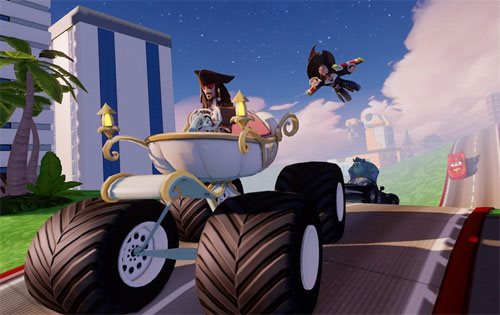
Copyright Disney Enterprises, Inc. All rights reserved
In the Lego games players could combine weapons, vehicles
and character accessories to build new gaming experiences. In Disney Infinity
players could do similar things as well. For example players could grant Sulley
from Monsters University
the speed of Dash from the Incredibles using a booster pack. Booster packs were
sold separately and could be stacked to grant any character additional
abilities. Players could then place their hyperactive Sulley inside the ride
vehicle from the Dumbo the Flying Elephant and add missile launchers to the
side for a makeshift strike fighter. Players were free to fly around their
newly created level shooting at friends or opponents.
This all may sound sacrilegious to long-time Disney fans but
gamers had come to expect this type of creative freedom in their sandbox
titles. The figure collecting aspect of Infinity was pulled from the
Activision-Blizzard game Skylanders however the nuances in gameplay were quite
different. Skylanders played more like an action RPG. The game allowed players
to gain experience through combat and missions and help their character grow
and evolve. Character customization was a feature in Skylanders. Disney
Infinity did save the level progress on individual characters, making them
slightly faster or more durable in combat. It did not allow players to change
the appearance, colors and textures on their models though.
Each game world in Disney Infinity was different than
Skylanders and changed the basic way the game was played. Instead of an action
RPG Disney Infinity could be an action, sim and even racing game depending on
which set the player was using.
If Disney Infinity suffered from one thing it would be the
ad campaigns, they did not do the gameplay justice. There had been a heavy
focus on the character cameos and "Toybox" levels in the commercials.
The Toybox was a virtual landscape that players could add themes to, create and
shape their own unique experiences in. It gave players the ability to do things
that couldn't be possible in the real world, essentially bringing their toys to
life. Gamers could build floating islands, working puzzles and even opponents
that fought back. Gamers could also have friends play within these environments
in 2-player or online modes. The Toybox could appeal very strongly to gamers
that enjoyed the same things that made the Toy Story 3 or Banjo Kazooie games
great.

Copyright Disney Enterprises, Inc. All rights reserved
But not every gamer was interested in just building
experiences. That was why Disney Interactive included fully realized game
stages known as the Playset for each franchise. The Playset was created from
the traditional formula of levels and stages with a narrative, missions and a
clear objective.
Disney Infinity was not just about building and creating but
also about actually taking a central role in these worlds. The details for each
stage were lifted from the parks, animation and film legacy. Speaking with the
developers at the public showings they said that Disney allowed them to incorporate
supporting details from their vast library without objection, so long as it fit
the theme of the game. These details included audio cues and music from
individual franchises. The game featured voice actors that tried to recreate
the nuances of the characters they were based on. Some voices were well done
while others were not as convincing.
The starter set allowed for players to explore Metroville
from the Incredibles, the islands from Pirates of the Caribbean
or Monsters University.
Players in the PotC levels could see elements from the classic dark ride right
away and as they got further into the world they could see a mix of elements
from the movies as well as new locations created just for the game. A variation
of the epic Hans Zimmer music underscored the levels. It helped frame the sword
fights and action sequences as it had in the films. The music would then slow
down to a soft shanty while exploring a port, or rhythmic, tribal-almost-Incan
song for exotic locations. The free spirited mini games would switch genres to
zydeco. The level of detail in the musical queues followed every Playset.
For Monsters University
the '80s inspired pop ballads that framed the college experience of Mike and
Sulley were recreated as background themes on the stages. Players could travel
between Roar Omega Roar, Jaws Theta Chi, Oozma Kappa and the other fraternities
while rocking out to power ballads that never really were.

Copyright Disney Enterprises, Inc. All rights reserved
Every Toybox was richly themed, so much so that it made me
wonder if some of the designers were not moonlighting as Imagineers. These
artists and programmers had crafted a world that supported the suspension of
disbelief created in the opening moments of the game. The players were not
really taking on the roles of Jack Sparrow or Davy Jones for example. They were
instead controlling toys in the likeness of Sparrow and Jones using the
"Spirit of Imagination."
There was violence in some of the Playsets but it was
"pretend violence." The sword fights in Pirates of the Caribbean
never drew blood and the flintlock pistols were always capped with a red safety
tip. Gore was nonexistent as defeated opponents simply fell apart like broken
action figures.
There was still a sense of awe and scale within each
Playset. When players took to the high seas in PotC they were rolling with the
enormous swells on the ocean and as far as the eye could see it was all free to
explore. It rekindled memories from the AAA game blockbusters Assassins Creed
and Uncharted but now for a younger crowd.
SPOILER ALERT: There were even naval battles on the high
seas, where players could switch artillery and target multiple ships with the
aid of a partner. The epic seagoing battles would have made the film producers
proud. It was then that I wondered why the commercials did not sell gamers on
the actual gameplay of Infinity instead of just the Toybox.

Copyright Disney Enterprises, Inc. All rights reserved
The stages in the Playsets were as well done as those in the
Lego titles. In fact they had a bit more to offer considering there were three
complete Playsets in the starter set, each with over a half-dozen hours worth
of unique gameplay stories and side missions.
When players were wandering around the campus of Monsters U
there were telltale signs that this was a living, breathing school. Monsters
carried textbooks and hurried from class to class, bulletin boards were
plastered with ads, parties, and job offers. Bikes were locked to bike racks
and the orange leaves of the fall semester littered the campus. As far as the
eye could see players were in the world of Monsters
U.
The same sense of scale and awe was in Metroville and every
expansion set released so far. The wild west in the Lone Ranger, Radiator
Springs from Cars could not have been done better. When players were in the
world, they were really IN the world. To help reinforce the theme each Playset
could only be explored by the characters from that particular franchise.
Those hoping to drive around Metroville as Lightning McQueen
or have the Lone Ranger visit Monsters
University would be sorely
disappointed. The game detected which characters were in play and would not
allow gamers to switch them for an incompatible character in any Playset. The
game did allow players to swap out for other compatible characters on the fly.

Copyright Disney Enterprises, Inc. All rights reserved
Why was this important? It forced the game to stay true to
the narrative. Objectives in each game were suited for each character type. The
hack and slash gameplay of PotC would not have worked within the racing world
of Cars. Conversely the Cars would be at a loss if they had to scale buildings
and fight the robots in Metroville.
The separation of each Toybox world also meant that
returning to each world would be a unique experience. Players were rewarded
with items for the Toybox for exploring each Playset, completing side missions
and mini games.
The ability to swap out for compatible characters could even
resolve conflicts in the real world. Let's say that two kids wanted to play as
Captain Jack Sparrow in the same PotC Playset or Toybox. In other games they
had to take turns playing as the hero but if they both had the same figure then
there wasn't a problem for Infinity. The game worked just as well with two of
the same character as it did with one, or even four of the same character if
friends joined in online.
The Playsets did highlight a weakness with the game however.
The sets that were built around a fast-paced IP, like Pirates, Cars or the Lone
Ranger, translated well to an action experiences. Those that were rooted in
drama or comedy, like Monsters University,
had a harder time engaging players. Disney Interactive struggled to add
gameplay elements and it showed. Giving Mike and Sulley a toilet
paper-launching gun and scooter were attempts to liven up an otherwise bland
Playset. The studio would have to consider the benefits of using a fan favorite
character instead of adapting a franchise that lent itself to actual gameplay
for future expansions.

Copyright Disney Enterprises, Inc. All rights reserved
Those that wanted to play with all of their toys and virtual
items outside of the Playset could do that in the Toybox mode. Mixing and matching
items unlocked by the game was one of the highlights of the Toybox. All of the
available Disney properties, with the exception of Marvel and Star Wars, were
represented here. Theme packs could be unlocked that allowed players to dress
up vehicles in the Playset or change the entire world of the Toybox. Elements
from each Playset level could be pulled into the Toybox. The virtual
environment could then have a global theme applied to it. A retro videogame
theme for example could pixelate the sky and clouds in the Toybox. Textures
would seem blocky, as if they had been built from the world of Wreck-it-Ralph.
The music in the Toybox would even change to mimic the trendy 8-bit
"chiptunes."
The Toybox was not a static world either. Non-playable
pedestrian characters wandered throughout and could be dressed up like classic
Disney heroes and villains using costume upgrades. Guards from Tangled could
fight side by side with robots sent by Syndrome. Pedestrians dressed like
Winnie the Pooh or Muppet characters could be seen wandering around the Toybox
as well. Players could stick to canon and build a faithful reproduction of a
Disney Parks landmark using only matching pieces. Or they could really let
their imagination run wild. A waterside on top of a pirate ship that rocketed
players into a saloon? This was possible but there was much more to the editor
than random assembling.
The Toybox creation tools were robust but placing and
setting up items required a bit of practice. The control and organizational
system did not seem intuitive and required much practice to learn. The creation
tools in Disney Infinity also did not have the fine tuning features of
Minecraft or Little Big Planet. Set pieces in Infinity were fixed shapes that
could be moved, scaled and rotated but not disassembled. In the other building
game players could shape, paint and texture an entire item or strip it down and
rebuild it completely new.
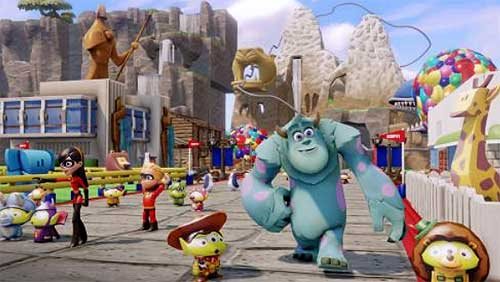
Copyright Disney Enterprises, Inc. All rights reserved
Disney Infinity did offer a large collection of gameplay
triggers though to counter the lack of precise editing. Players could create
virtual missions, host treasure hunts, and recreate entire classic arcade
levels if they chose to. They could fix camera angles, have opponents pop up at
specific intervals, build counters, rewards and elaborate Rube Goldberg
contraptions if they wanted to. All they needed was a little imagination.
Disney Infinity had much more than level building and
character mash-ups to offer but it would be hard to convince gamers that this
was a worthy investment. The idea of collectable figures and blind-pack booster
packs seemed like a cash grab to the fickle community. The loyalty to Minecraft
and Skylanders was still strong among gamers and Disney did not have the best
gaming track record. Titles with the Disney label had been more mediocre than
memorable over the past 25+ years. Granted there were standout moments like Castle
of Illusion and DuckTales which
were both remade for the current generation. The majority of the time Disney
Interactive released a poor to average gaming experience for a film that was
about to debut. There were no original ideas, nothing that could compare with
the Gears of War, Assassins Creed, Uncharted or the other blockbuster games
from major publishers.
When Disney Interactive tried to be completely original, as
in Epic Mickey, the ambition outgrew the experience. Gamers loved the attention
to detail and reintroduction of Oswald and Ortensia but were frustrated with
the camera and controls. They were expecting a different gameplay experience
altogether. The lessons from Epic Mickey were not lost on Infinity. Disney
Interactive did include members from the Junction Point studio that created
Epic Mickey after all.
Disney Infinity also incorporated the tiniest details from
the films, cartoons and theme parks. It made good use of music, voice acting
and storytelling to help immerse players into the world. It solved the control
issue by giving characters familiar attack and defend capabilities that players
could learn quickly. It used a simple camera setup so players could easily
follow the action and adjust the angle on the fly.

Copyright Disney Enterprises, Inc. All rights reserved
When we first started a Playset stage Alice and I found it
extremely easy to get into, control and play. We were well into the story
without having to second-guess our choices, not at all like our experience with
Epic Mickey 2. The aesthetic of the game was the strongest draw for gamers and
even non-gamers.
Classic and modern characters were all re-imagined as
stylized toys so that they all shared a common theme. Even though Mickey Mouse
was pushing 90 he looked as young and vibrant as Vanellope Von Schweetz from
last year's Wreck-it-Ralph. Live action and television characters also fit into
the world of Infinity seamlessly using the same aesthetic. This was a game that
could continue to grow and evolve well beyond the initial release. This was the
franchise that the studio had hoped for.
Finding out what made great games unique was part of the
challenge laid out to Disney Interactive. The proposal came from the top, Bob
Iger the CEO of Disney was aware that the culture surrounding the company had
changed. Pixar had inspired fans the way that Disney Animation studios once
had. Yet the characters from both studios were only getting older and films and
cartoons were not being produced rapidly enough to keep them relevant.
In order to help audiences reconnect with the mascots,
Disney had to reach out to them in new ways. Disney cartoons and comic books
had seemingly run their course in the USA.
Videogames had been ignored by the company in the early days. As a result a
generation was lost to Nintendo and the other big publishers. Consoles had
become more influential than the Mickey Mouse Club in that time. Game studios
had snapped up the talent that would have become animators or Imagineers in an
earlier era.
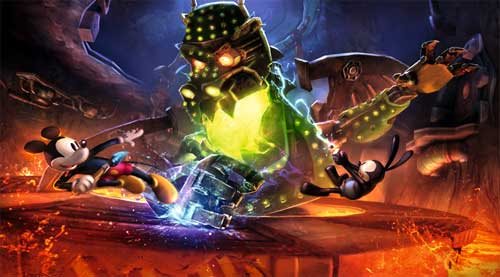
Copyright Disney Enterprises, Inc. All rights reserved
It was painfully obvious to Iger and the senior people at
Disney that gaming was not a fad but a benchmark for modern entertainment. In
less than 30 years it had surpassed film as the highest grossing entertainment
product and showed no sign of slowing. Disney would have to become a major
player in the industry or lose touch with and creative control of their icons
for another generation.
Disney remained diligent about making headway into the new
standard. Warren Spector was tabbed to create a Triple-A original game for the
studio. The mandate was to make Mickey Mouse relevant and bring back Oswald to
public consciousness. Gamers may consider the Epic Mickey series a failure but
Disney had barely taken its first steps towards a long-term goal. The studio
had an understanding that the current and next generations were being raised on
a steady diet of fantastic gaming experiences.
Epic Mickey was a good attempt at launching a new franchise
but audiences wanted something different. They had grown up expecting more
immersion and interactivity from the entertainment they consumed. In order for
Disney to connect with these people, to make their characters iconic once more,
they had to rethink their strategy. The studio made a more concentrated effort
to incorporate interactivity in the theme parks and on home consoles as well.
They had to give the creation tools to audiences and let them build their own
unique experiences. They had to figure out a way to share these experiences
with friends and family.
The creation tools for Little Big Planet had worked so well
for Sony that it became a recruiting tool for the publisher. Young designers
were hired based on the quality and content of the levels they had created in
the sleeper hit. Disney may be able to spot new talent in the wild by combing
through the Toyboxes of players or ask for a level sample instead of a demo
reel for Disney Interactive.
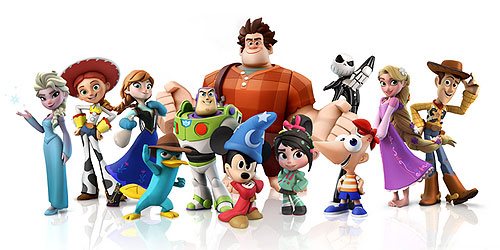
Copyright Disney Enterprises, Inc. All rights reserved
Collectable items and gaming had done well together in the
past. Pokémon and Skylanders showed that millions and even billions of dollars
could be made from a great platform. Instead of chasing the elusive AAA
blockbuster game, the Uncharted or Assassin's Creed equivalent, Disney instead
focused on creating the next platform. The company managed to build that
platform and sidestep the competition. The game was unique enough that fans of
Minecraft, Lego and Skylanders could still find something compelling in
Infinity.
Moreover fans of traditional racing games, fighting games,
shooters and action titles could also be drawn to Infinity. Instead of
releasing a console exclusive, as was the case with the original Epic Mickey,
Infinity was available on all the major consoles the very first day. To
simplify things the collectable figures and booster packs would work on every
console. Parents did not have to worry if they got the Wii version or Xbox360
version of a particular character or Playset because they were all identical.
The platform had a robust base and expansion sets would keep audiences engaged for
weeks, months and potentially years.
Disney had created buzz at the D23 in Anaheim
this past month by announcing the inclusion of the Nightmare Before Christmas,
Phineas and Ferb, Frozen and Wreck-it-Ralph characters in the next expansion.
Speculation had run rampant in the Disney and gaming communities as to what the
next Playset would be. Would audiences see the Hatbox Ghost become a playable
character? What about the Little Mermaid, Pinocchio or Beauty and the Beast?
Would seasonal Toybox themes be released?
Audiences were eager for a fan-favorite character to appear
next. Others wondered about the other Disney-owned franchises, like Star Wars
or Marvel, would they get an Infinity set all their own. There was the
potential for Disney Interactive to grow as large as Blizzard if they could
find their audience and control the format. As a platform Infinity could
support the entire Disney IP for the next five or even ten years. It could be
the long-term goal that Bob Iger was looking for. It could keep every Disney,
Pixar, Marvel, Muppet and Star Wars franchises alive and relevant to the next
generation.

Copyright Disney Enterprises, Inc. All rights reserved
Provided that every release of the game had the same level
of detail of the first then relevancy was an attainable goal. The biggest
challenge for the studio would be to get enough sets sold between now and
holiday 2013 to make the series sustainable. Otherwise this would turn out to
be a very expensive gamble. Retailers were certainly doing their part. Since
the release of Infinity three of the major retailers Toys R Us, Wal Mart and
Target were constantly running sales against each other. Fifty percent off, buy
one-get-one and other promotions had helped expose shoppers to the game and get
booster packs and figures into the hands of very passionate collectors.
JHM will be tracking future releases of this game very carefully. For now you
will have to excuse me. Mr. Incredible has some robots to smash.
Video Games & Technology
“Adventure Time: Pirates of the Enchiridion” game coming this summer

“C’mon on, grab your friends … ” A new Adventure Time game is coming out across multiple platforms.
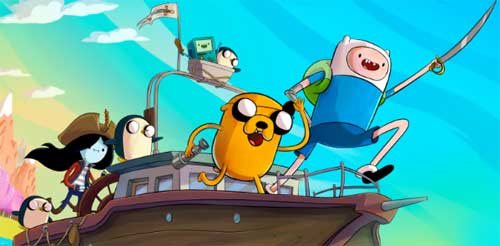 Copyright Cartoon Network / Outright Games Ltd. All rights reserved
Copyright Cartoon Network / Outright Games Ltd. All rights reserved
In this open world game, Finn and Jake will be sailing on a raft (Named Jeff) through the flooded land of Ooo to solve the mystery of why water engulfed their home and to help others & get in hijinks along the way. With a ragtag gang of friends (From a vampire, to an Ice King, to a little robot) Finn and Jake will travel from the melting Ice Kingdom to the Fire Kingdom and fight in turn-based combat like an RPG.
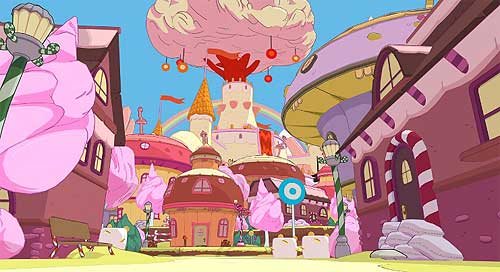 Copyright Cartoon Network / Outright Games Ltd. All rights reserved
Copyright Cartoon Network / Outright Games Ltd. All rights reserved
The trailer shows off some absolutely gorgeous character models and environments. I’m particularly enchanted by the gorgeous Candy Kingdom that’s briefly shown in this footage. The art design sticks close to the show, but brings with it a soft, sweet design rarely seen in adventure games. Which is a refreshing thing to bring to the table. Likewise, it’s a joy to see the characters translate to 3D so well. Outright Games has done some fantastic work here with their art design.
 Copyright Cartoon Network / Outright Games Ltd. All rights reserved
Copyright Cartoon Network / Outright Games Ltd. All rights reserved
Likewise, the voice cast for the show will be reprising their roles as characters in the land of Ooo. And they’ll have a lot of lines to record. Not only can you control Finn and Jake, but you’ll be able to play as BMO and Marceline as well. You can upgrade these characters to unlock unique abilities for combat and the map holds plenty of fun mysteries too. With side stories and secret locations, this seems like a game that’ll have hours & hours of fun.
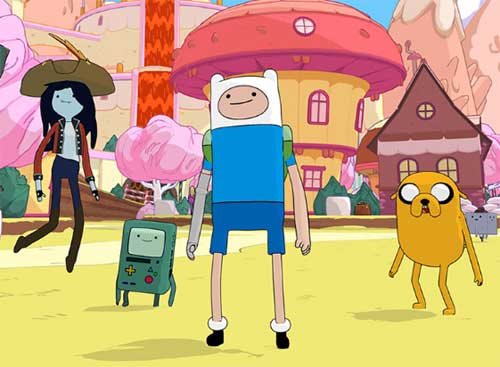 Copyright Cartoon Network / Outright Games Ltd. All rights reserved
Copyright Cartoon Network / Outright Games Ltd. All rights reserved
What strikes me particularly about this game is how much it resembles Legend of Zelda: Wind Waker. This is no coincidence. Adventure Time have a history of being direct corollaries to Legend of Zelda games. “Adventure Time: Hey Ice King! Why’d You Steal Our Garbage?!” ‘s gameplay references “Zelda II: The Adventure of Link” and “Adventure Time: The Secret of the Nameless Kingdom” has the same top down look & combat stylings as “Legend of Zelda: A Link to the Past.” With this in mind, it’s absolutely delightful to see a Wind Waker homage with a series like this. Wind Waker was a gamechanger for the Legend of Zelda series, and it feels like “Pirates of the Enchiridion” will be a gamechanger for the Adventure Time games.
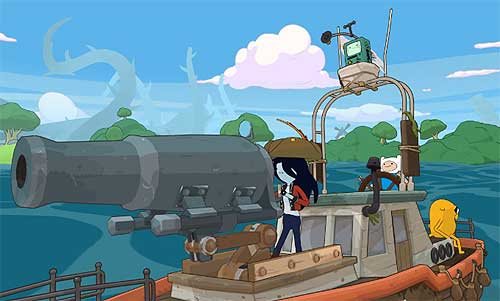 Copyright Cartoon Network / Outright Games Ltd. All rights reserved
Copyright Cartoon Network / Outright Games Ltd. All rights reserved
‘Adventure Time: Pirates of the Enchiridion’ will be out July 17th for the Nintendo Switch, Xbox One, Playstation 4, and PC.
Video Games & Technology
Do you like treasure hunting and/or cooking soup? Then Pokemon Quest is the game for you

Immediately after the Pokemon press conference on May 29th, the mobile-switch cross platform game Pokemon Quest was available to download on the Nintendo eShop (with the mobile device version debuting later this month). Curious about the ‘Free-to-Start’ game, I snagged a download and started playing.
 Copyright 2018 Nintendo. All rights reserved
Copyright 2018 Nintendo. All rights reserved
Pokemon Quest is a game that feels best letting itself auto-run. You check in several times a day to see what Pokemon have appeared at your camp (The conceit behind this game is that you’re a treasure hunter & Pokemon flock to you to fight their brethren in your honor. They also sometimes just come by because you make really good soup. What can I say?). With the Pokemon at your disposal, you build a small exploration team much in the same style as the Pokemon Mystery Dungeon game series. And you then set them out to fight other Pokemon in open levels. From these battles, you win power stones (which allow you to upgrade your Pokemon’s health & attack power), and ingredients to lure other Pokemon to your camp.
You may’ve taken notice use of the term ‘Free-to-Start’ earlier in this article. That’s because — like many mobile services — this game offers add-ons for purchase. I don’t see any age limit on the Nintendo Switch version to take away ads for purchases (which many mobile games have chosen to add. See Disney’s own ‘Disney Crossy Road’) but the Pokemon Company may be expecting parents to set their own controls over the switch with the parental controls available on the system.
 Copyright 2018 Nintendo. All rights reserved
Copyright 2018 Nintendo. All rights reserved
Still, the game is typical in mobile game fare for trying to wring money out of players. Energy to play the game costs P tickets, which you can earn 50 a day … or you can just buy. The game gives you an amount to start with, shows you how to use them to speed up your game, and then takes you to the shop where you can see an advertisement to buy it — along with Pokemon furniture to help your team.
These packages can go up to $30 and include Pokemon in-game items & exclusive furniture. And while Pokemon Go offered items in bundles like this, it’s still odd to see in a Pokemon game — let alone a Pokemon game on the Nintendo Switch (albeit, this is a cross-platform game). The game itself doesn’t seem to have any sort of hard-pay line for gameplay, though. I’m up to the fifth world in my game without making any purchases. And while the game difficulty has dramatically ramped up, likely to encourage purchases, it’s still completely manageable to play without paying.
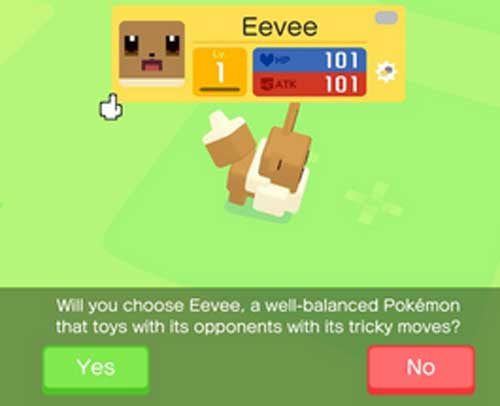 Copyright 2018 Nintendo. All rights reserved
Copyright 2018 Nintendo. All rights reserved
In that sense, for a free game, it’s really cute & enjoyable. The graphics are pleasing and colorful. And if you return to camp, you’ll find all the Pokemon you’ve befriended hopping around adorable decorations. Sometimes stacking on top of each other, other times following each other around in what seems like games of tag.
The ‘cooking’ mechanic to encounter a random Pokemon makes encountering them feel less like gambling and more like strategy. By cooking certain recipes from materials you find on missions, you can draw certain types of Pokemon to your camp. Cooking in certain pots (unlocked by playing through the game) can draw higher powered Pokemon at the cost of more materials. And waiting while your energy fills up means running out of ingredients (At the point of the game I’m at, about half-way through) doesn’t seem to be a problem.
 Copyright 2018 Nintendo. All rights reserved
Copyright 2018 Nintendo. All rights reserved
All in all, I’d say, if you have access to this game, check it out and see if it’s for you. There doesn’t seem to be cross platform support for other Pokemon games. But as a standalone, it’s a cute, fun blip of a game. The hard ‘end’ of the levels within surprises me, especially since it seems to end with 150 Pokemon (out of the over eight hundred available). So I’m not sure what there is to get out of it when you get to the end level outside of getting every Pokemon. But it’s still a fun, very casual strategy game. Just keep an eye on purchases if your children decide to play.
Video Games & Technology
“Pokemon — Let’s Go, Pikachu !” & “Pokemon — Let’s Go, Eevee !” to come to the Nintendo Switch this year

During a conference in Japan earlier this week, the Pokemon Company revealed three new games : A mobile and Nintendo Switch cross platform game, “Pokemon Quest,” with graphics similar to Crossy Road and some absolutely adorable furniture in a “free to start” format; and for the Nintendo Switch, “Pokemon — Let’s Go, Pikachu !” and “Pokemon — Let’s Go, Eevee !”
Taking inspiration from gameplay styles from the popular “Pokemon Go” for mobile devices, “Pokemon — Let’s Go, Pikachu !” and “Pokemon — Let’s Go, Eevee !’ adopts the thrown Pokeball system. By using one controller with the Switch system, you can make a tossing motion to throw a Pokeball and capture a cute critter for your team.
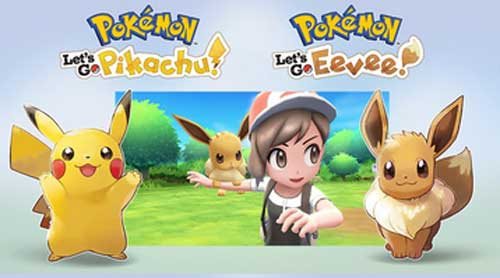
Additionally, you can buy the “Pokeball Plus” accessory to act as an additional “Joy-con” controller for your Switch to capture Pokemon. Then load a Pokemon into your pokeball, and take it out on the go.
From there, with the accessory, you’ll be able to interact with the Pokemon you have inside. Although current information doesn’t offer whether we’ll have more options than putting Eevee or Pikachu in the Pokeball Plus, the footage seen in the linked trailer is absolutely adorable.
The game itself seems to be a remake of Pokemon Yellow, a game released twenty years ago for the Game Boy Color. You explore the Kanto Pokemon region, and seem to be limited to the 150 Pokemon available when that game was out (Well, 151, if you were lucky, or good at exploiting glitches). But these games ditch the random encounters of mainline Pokemon games and adopt the overworld encounters of Pokemon Go. What Pokemon you see on the overworld is what you get.

Additionally, Pokemon can follow you around and you can ride some of them. In footage, we see a trainer riding a giant Onyx (i.e., a giant snake made out of rocks. Who wouldn’t be comfortable riding on that?) and followed by a starting Pokemon, Bulbasaur. Although in these two games, you start instead with the series mascot Pikachu, and the evolution Pokemon Eevee, which can evolve into several different pokemon. You can also put little outfits on them. Which is – frankly — incredible.
Likewise, this seems to have local multiplayer. Hand the left Joy-con to a friend and let them enter your game. Or if you’re feeling really lonely, put the left Joy-con in your hand and pretend you have a friend while controlling the new trainer that arrives. What a fun time!
You and your friend can then team up to capture Pokemon together, or go exploring together- And you can have Pokemon you capture in Pokemon Go (of the original 151 Pokemon) arrive in your game. You can also send “Presents” back to your Pokemon Go game, including a possible new form of Pokemon as the trailer discusses.
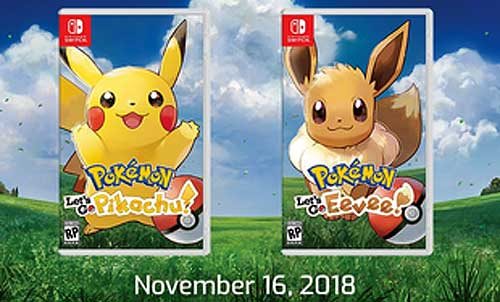
“Pokemon — Let’s Go, Pikachu !” and “Pokemon — Let’s Go, Eevee !” will be arriving on the Nintendo Switch this November. Likewise, a new Pokemon game will be released in the second Half of 2019. With a Mario movie in development and theme park additions on the way, it’s sure to be a busy year for Nintendo.
-

 Film & Movies7 months ago
Film & Movies7 months agoBefore He Was 626: The Surprisingly Dark Origins of Disney’s Stitch
-

 History5 months ago
History5 months agoCalifornia Misadventure
-

 History10 months ago
History10 months agoThe Super Bowl & Disney: The Untold Story Behind ‘I’m Going to Disneyland!’
-

 Television & Shows11 months ago
Television & Shows11 months agoHow the Creators of South Park Tricked A-List Celebrities to Roast Universal – “Your Studio & You”
-

 Film & Movies7 months ago
Film & Movies7 months agoThe Best Disney Animation Film Never Made – “Chanticleer”
-

 Theme Parks & Themed Entertainment6 months ago
Theme Parks & Themed Entertainment6 months agoThe ExtraTERRORestrial Files
-

 History7 months ago
History7 months agoWhy Disney’s Animal Kingdom’s Beastly Kingdom Was Never Built
-

 Television & Shows8 months ago
Television & Shows8 months agoThe Untold Story of Super Soap Weekend at Disney-MGM Studios: How Daytime TV Took Over the Parks






